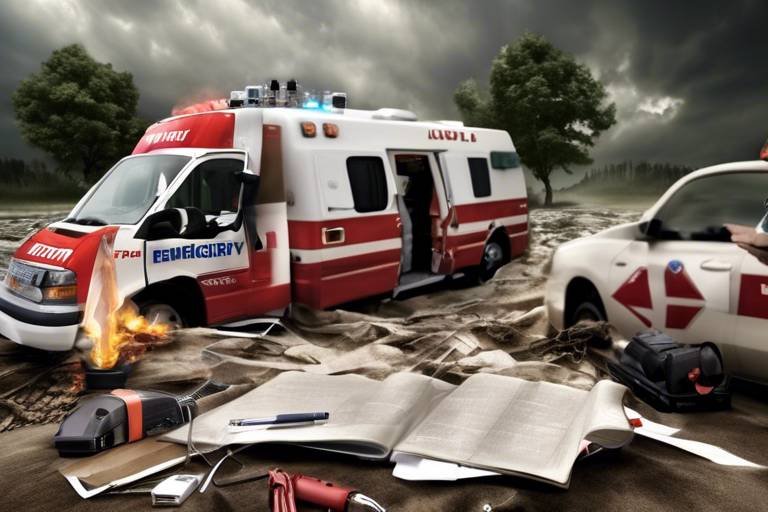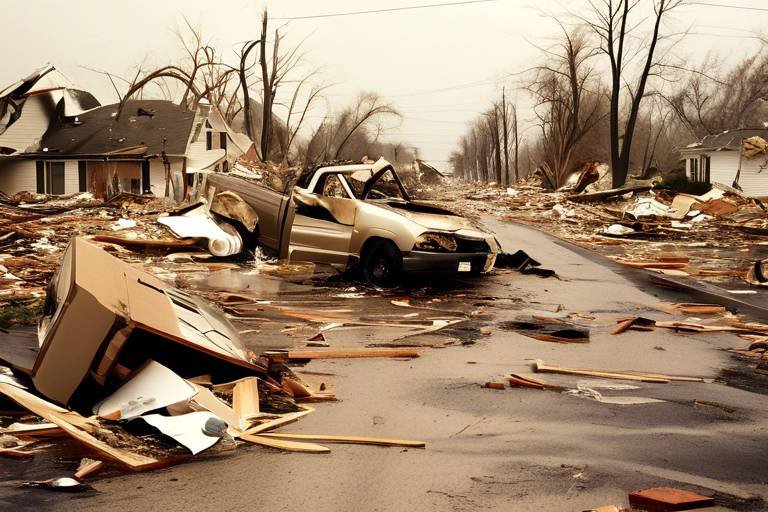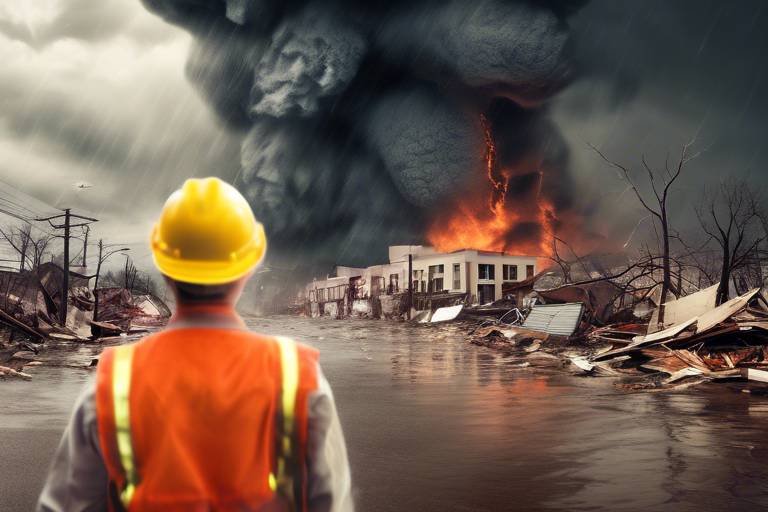Emergency Preparedness for Visually Impaired People
In today's world, being prepared for emergencies is crucial, and this holds especially true for visually impaired individuals. While everyone should have a plan, those with visual impairments face unique challenges that require tailored strategies to ensure their safety and well-being. Imagine navigating through chaos without the ability to see; it can be daunting. However, with the right preparation and resources, visually impaired individuals can enhance their safety and confidence during emergencies.
This article delves into essential strategies and resources that can make a significant difference in emergency preparedness for visually impaired people. From understanding the unique challenges they face to creating a personalized emergency plan, we will explore various aspects to help ensure safety during crises. The road to preparedness is not just about having a plan; it’s about empowering individuals and fostering a supportive community.
Visually impaired individuals encounter specific challenges during emergencies that can complicate their response and recovery. For instance, navigating through unfamiliar environments can be particularly difficult when panic sets in. They often rely on others for assistance, which can lead to delays and confusion. Recognizing these challenges is not just important; it's the first step toward effective emergency preparedness planning. By understanding the hurdles that visually impaired individuals face, we can better equip them with the tools and knowledge they need to respond effectively in emergencies.
Developing a personalized emergency plan is vital for visually impaired individuals. This plan should outline evacuation routes, communication methods, and designated assistance personnel to ensure safety during crises. It’s like having a roadmap in a city you’ve never visited before; without it, you might feel lost and overwhelmed. The plan should include:
- Evacuation Routes: Clearly marked paths that are accessible and easy to navigate.
- Communication Methods: How to reach out for help, whether through phone calls or alert systems.
- Designated Assistance Personnel: Identifying who can provide help during an emergency.
Knowing safe locations within a home and community is essential. This includes identifying accessible exits, shelters, and landmarks that can aid in navigation during emergencies. Think of it as creating a mental map; the more familiar you are with your surroundings, the more confident you will feel when you need to act quickly. Safe locations can include:
- Accessible exits from buildings.
- Community shelters that are equipped to assist visually impaired individuals.
- Landmarks that are easy to recognize and navigate towards.
Technology can significantly enhance safety for visually impaired individuals. Tools like GPS apps and smart home devices can assist in navigation and communication during emergencies. Imagine having a personal assistant that guides you through the chaos, providing real-time updates and directions. This technological support can be a game-changer, transforming how visually impaired individuals respond to emergencies.
Local organizations and resources play a crucial role in emergency preparedness. Connecting with community support groups can provide valuable information and assistance tailored for visually impaired individuals. These groups often have resources and training programs designed to empower individuals and equip them with the knowledge they need to stay safe. Building a network of support can be incredibly beneficial, creating a safety net that individuals can rely on during emergencies.
Regular training and emergency drills are essential for visually impaired individuals. Practicing evacuation procedures and familiarizing oneself with emergency equipment can boost confidence and readiness. It’s akin to rehearsing for a play; the more you practice, the more comfortable and prepared you feel when the curtain rises. Training should include:
- Hands-on practice with emergency equipment.
- Mock evacuation scenarios to build confidence.
- Regular updates to the emergency plan as circumstances change.
Effective communication is key during emergencies. Establishing clear communication methods with family, friends, and emergency services can ensure timely assistance and information dissemination. It’s like having a lifeline; when you know how to reach out for help, you can navigate through tough situations more effectively.
Maintaining an updated list of emergency contacts is crucial. This list should include family members, friends, and local services that can provide support during emergencies. Consider having this information in multiple formats, such as braille or audio, to ensure accessibility. Having a reliable network can make all the difference when seconds count.
Accessing emergency information in an accessible format is vital. Utilizing audio alerts, braille materials, and other adaptive technologies ensures that visually impaired individuals receive critical updates promptly. Imagine being in a crowded room and hearing an announcement that could save your life; having this information readily available is essential for safety.
Q: What should I include in my emergency plan?
A: Your emergency plan should include evacuation routes, communication methods, and a list of designated assistance personnel.
Q: How can technology help me during an emergency?
A: Technology, such as GPS apps and smart home devices, can assist with navigation and communication in emergencies.
Q: Why is community support important?
A: Community support provides valuable resources and training tailored for visually impaired individuals, creating a safety net during emergencies.

Understanding the Unique Challenges
This article covers essential strategies and resources to ensure the safety and preparedness of visually impaired individuals during emergencies, highlighting communication, training, and community support.
When it comes to emergencies, visually impaired individuals encounter a myriad of challenges that can complicate their response and safety. Imagine being in a crowded building when an alarm goes off, and you can’t see the nearest exit. This scenario illustrates the navigation difficulties faced by those who rely on their other senses to interpret their surroundings. The absence of visual cues can create disorientation, making it hard to gauge distances or detect obstacles. In such high-pressure situations, the stakes are incredibly high, and understanding these challenges is the first step toward effective emergency preparedness.
Moreover, many visually impaired people depend on others for assistance during crises. This reliance can lead to increased anxiety, especially if the designated helpers are also caught off guard or unsure of how to assist. It's crucial to recognize that not all emergencies allow for the luxury of time. Therefore, having a plan that includes designated assistance personnel is vital. This ensures that help is both readily available and capable of providing the necessary support.
Additionally, the emotional toll of an emergency can be overwhelming. Visually impaired individuals may feel isolated or vulnerable, particularly if they are not familiar with their environment. This emotional stress can hinder their ability to think clearly and respond effectively. To combat this, community support plays a critical role. Building a network of friends, family, and neighbors who are aware of these challenges can foster a sense of safety and preparedness.
To summarize, the unique challenges faced by visually impaired individuals during emergencies can be categorized as follows:
- Navigation Difficulties: Lack of visual cues can lead to disorientation.
- Reliance on Others: Dependence on designated helpers can create additional stress.
- Emotional Impact: Feelings of isolation and vulnerability can hinder effective responses.
- Community Support: Having a network can significantly improve preparedness and response.
By acknowledging these challenges, we can take proactive steps to ensure that visually impaired individuals are equipped with the knowledge and resources they need to navigate emergencies safely. It’s not just about having a plan; it’s about creating an environment that fosters confidence and readiness.
Developing a personalized emergency plan is vital for visually impaired individuals. This plan should outline evacuation routes, communication methods, and designated assistance personnel to ensure safety during crises.
Knowing safe locations within a home and community is essential. This includes identifying accessible exits, shelters, and landmarks that can aid in navigation during emergencies.
Technology can significantly enhance safety for visually impaired individuals. Tools like GPS apps and smart home devices can assist in navigation and communication during emergencies.
Local organizations and resources play a crucial role in emergency preparedness. Connecting with community support groups can provide valuable information and assistance tailored for visually impaired individuals.
Regular training and emergency drills are essential for visually impaired individuals. Practicing evacuation procedures and familiarizing oneself with emergency equipment can boost confidence and readiness.
Effective communication is key during emergencies. Establishing clear communication methods with family, friends, and emergency services can ensure timely assistance and information dissemination.
Maintaining an updated list of emergency contacts is crucial. This list should include family members, friends, and local services that can provide support during emergencies.
Accessing emergency information in an accessible format is vital. Utilizing audio alerts, braille materials, and other adaptive technologies ensures that visually impaired individuals receive critical updates promptly.
Q1: What should I include in my emergency plan?
A: Your plan should outline evacuation routes, communication methods, and designated assistance personnel. Make sure to practice this plan regularly.
Q2: How can technology help during emergencies?
A: Technology such as GPS apps and smart home devices can assist in navigation and communication, making it easier to respond during emergencies.
Q3: What community resources are available for visually impaired individuals?
A: Local organizations often provide support groups, training sessions, and resources specifically designed to aid visually impaired individuals during emergencies.

Creating an Emergency Plan
When it comes to emergencies, having a well-thought-out plan is not just a luxury; it’s a necessity, especially for visually impaired individuals. Imagine being in a situation where every second counts, yet you’re unsure of where to go or what to do. This is why creating a personalized emergency plan is crucial. It’s about more than just knowing the exits; it’s about ensuring that every step you take is informed and intentional.
Your emergency plan should be tailored to your unique needs and circumstances. Start by outlining your evacuation routes. These routes should not only include the quickest paths out of your home but also consider the accessibility of those paths. For instance, if you live in a multi-story building, identify which stairwells are safe and accessible. You might want to practice these routes with a trusted friend or family member, so you feel comfortable navigating them independently.
Next, think about how you will communicate during an emergency. Establishing methods for reaching out for help is vital. This could include having a designated contact person who knows how to assist you or using technology like smartphones equipped with emergency apps. It’s also wise to have a reliable source of information, such as a radio or a smartphone app that provides updates on emergencies in your area.
Another essential component of your emergency plan is identifying designated assistance personnel. These are individuals who are aware of your situation and can assist you if needed. It could be neighbors, friends, or family members. Make sure they know your plan and are willing to help you execute it during a crisis. Having a support network can make all the difference when the unexpected happens.
Additionally, take the time to create a checklist of essential items to have ready in your emergency kit. This kit might include:
- Medical supplies and medications
- Personal identification
- Emergency contact information
- Flashlight with a tactile feature
- Portable charger for your phone
Always keep your emergency kit in an easily accessible location, and ensure that those who may assist you know where it is. Regularly review and update your plan to accommodate any changes in your living situation or personal needs. Remember, the goal is to create a sense of safety and preparedness that empowers you to act swiftly and confidently when it matters most.
By taking these steps, you’re not just preparing for an emergency; you’re building a foundation of resilience that can help you navigate life’s challenges with greater ease. So, why wait? Start crafting your emergency plan today and ensure that you’re ready for whatever life throws your way!

Identifying Safe Locations
When it comes to emergency preparedness for visually impaired individuals, identifying safe locations is not just important; it’s absolutely essential. Imagine being in a situation where every second counts, and knowing where to go can make the difference between safety and chaos. Safe locations include not only exits from your home but also public spaces that can serve as shelters during an emergency.
First and foremost, it's crucial to map out your home. This means knowing the layout like the back of your hand. Identify accessible exits, such as doors and windows, and ensure they are free of obstacles. Consider the use of tactile markers or braille labels on doors and exits to facilitate quick navigation. For example, you could place a textured mat near the exit door to signal its location. This small change can be a lifesaver in a panic situation.
Next, think about your community. Are there local shelters or community centers that are accessible? Familiarize yourself with these locations and how to get there. You might even want to take a few trips to these places during non-emergency times to get a feel for the environment. Knowing where to go can ease the anxiety that often accompanies emergencies. If you have friends or family nearby, discuss these locations with them and make sure they are aware of your plan.
Another key aspect is identifying landmarks that can assist in navigation. Landmarks can be anything from a specific tree in a park to a distinctive building in your neighborhood. These points of reference can serve as guides during an emergency. You might even want to create a list of these landmarks and practice navigating to them. This can help build confidence and familiarity with your surroundings.
Lastly, don’t underestimate the power of technology in identifying safe locations. GPS apps designed for the visually impaired can provide audio cues and descriptions of your surroundings. These tools can guide you to safe places, ensuring you are not left scrambling during a crisis. Additionally, consider setting up a network of friends or family who can assist you during emergencies, offering both emotional support and practical help.
In summary, identifying safe locations is a multi-faceted approach that involves understanding your home, knowing your community, recognizing landmarks, and utilizing technology. By taking the time to prepare, you can transform a potentially overwhelming situation into one where you feel empowered and in control. After all, being prepared is not just about having a plan; it’s about knowing exactly where to go when you need it the most.
- What should I include in my emergency plan?
Your emergency plan should include evacuation routes, communication methods, and a list of designated assistance personnel. - How can technology help visually impaired individuals in emergencies?
Technology can provide navigation assistance through GPS apps and smart devices, making it easier to find safe locations. - Where can I find community resources for emergency preparedness?
Local organizations and support groups often provide valuable information and resources tailored for visually impaired individuals. - How often should I practice my emergency plan?
Regular practice, ideally every few months, can help ensure you are familiar with your emergency procedures and feel confident in your ability to act quickly.

Utilizing Technology
In today’s world, technology serves as a powerful ally, especially for visually impaired individuals navigating the complexities of emergency situations. Imagine having a trusty companion by your side, guiding you through the chaos of an emergency. That's what the right technology can do! From GPS applications to smart home devices, these tools not only enhance safety but also empower individuals to act swiftly and confidently when it matters most.
One of the most significant advancements is the use of GPS navigation apps. These applications are designed to provide audio instructions and real-time updates, allowing users to navigate unfamiliar environments with ease. For instance, apps like BlindSquare and Seeing Eye GPS offer auditory cues that help users identify street names, nearby landmarks, and even the location of emergency services. This can be crucial during an evacuation when every second counts.
Moreover, smart home technology can significantly enhance safety. Devices such as smart speakers and home automation systems can be programmed to provide alerts and reminders. Imagine receiving a voice notification that an emergency alert has been issued or that it's time to evacuate. This kind of immediate communication can be lifesaving. Additionally, smart door locks and security systems can be controlled remotely, allowing for quick access to exits without the need for physical keys, which can be a challenge in stressful situations.
Furthermore, wearable technology, such as smartwatches equipped with emergency features, can be invaluable. These devices can detect falls, send alerts to emergency contacts, and even provide location tracking. This means that if a visually impaired individual finds themselves in a precarious situation, help can be dispatched promptly, thanks to the technology they wear on their wrist.
It's also important to consider the role of adaptive technologies, which can transform how visually impaired individuals receive information. For example, text-to-speech software can convert written emergency alerts into audible messages, ensuring that critical information is accessible. Braille displays and tactile maps can also aid in understanding evacuation routes and safe locations.
Ultimately, the integration of technology into emergency preparedness for visually impaired individuals is not just about having the latest gadgets; it’s about creating a comprehensive safety net that fosters independence and confidence. By leveraging these tools, visually impaired individuals can ensure they are not only prepared but also empowered to face emergencies head-on.
- What types of technology are most effective for visually impaired individuals during emergencies?
GPS apps, smart home devices, and wearable technology are among the most effective tools, providing navigation assistance and emergency alerts. - How can I ensure my emergency plan includes technology?
Incorporate devices that can provide alerts and assistance, such as smartphones, smart speakers, and adaptive technology that supports communication. - Are there specific apps designed for emergency preparedness for the visually impaired?
Yes, apps like BlindSquare and Seeing Eye GPS focus on providing auditory navigation and emergency information tailored for visually impaired users.

Community Resources
When it comes to emergency preparedness, community resources are like a lifeline for visually impaired individuals. These resources not only provide essential support but also create a network of safety and assurance. Imagine being in a situation where every second counts; having a trusted community can make all the difference. Local organizations, advocacy groups, and volunteer services often offer tailored programs that focus on the specific needs of visually impaired individuals. By connecting with these resources, individuals can gain access to valuable information, training, and assistance that can significantly enhance their readiness for emergencies.
One of the most effective ways to engage with community resources is by participating in local workshops and training sessions. These events are designed to educate visually impaired individuals on how to navigate emergencies effectively. They often cover topics such as:
- Understanding local emergency services
- Learning about accessible evacuation routes
- Practicing communication strategies
- Identifying safe locations in the community
Moreover, many organizations offer volunteer programs that can connect visually impaired individuals with trained volunteers who can provide assistance during emergencies. This support can range from helping with evacuation procedures to ensuring that important information is communicated clearly and promptly. Building these relationships not only fosters a sense of community but also empowers visually impaired individuals to take charge of their safety.
It's also worth noting that some community resources provide technology training, which is increasingly important in today’s digital world. For instance, learning how to use smartphones equipped with GPS or other navigation apps can be a game-changer during emergencies. Local libraries and community centers often host free classes that teach these valuable skills, ensuring that visually impaired individuals are not left behind in times of crisis.
In addition, many cities have established partnerships with local emergency services to ensure that they are equipped to assist visually impaired individuals effectively. These partnerships often lead to the creation of resource guides that outline the specific services available, including transportation options, shelters, and emergency hotlines. Being aware of these resources can provide peace of mind, knowing that help is just a call away.
In summary, community resources play a pivotal role in emergency preparedness for visually impaired individuals. By leveraging these resources, individuals can enhance their safety, build confidence, and develop a robust support network that can be invaluable during emergencies. Remember, the more connected you are with your community, the safer you’ll feel when facing unexpected challenges.
Q1: What types of community resources are available for visually impaired individuals?
A1: Community resources can include local organizations that provide training, volunteer assistance, and technology support specifically designed for visually impaired individuals. These resources often focus on emergency preparedness and safety.
Q2: How can I find community resources in my area?
A2: You can start by contacting local advocacy groups for the visually impaired, community centers, or libraries. They often have information on available resources, workshops, and support services.
Q3: Are there any specific technologies that can help during emergencies?
A3: Yes, technologies such as GPS navigation apps, smart home devices, and emergency alert systems can greatly assist visually impaired individuals in navigating emergencies more effectively.
Q4: How often should I participate in training and drills?
A4: It’s recommended to engage in training and drills at least once or twice a year to stay familiar with emergency procedures and maintain confidence in your ability to respond.

Training and Drills
When it comes to emergency preparedness for visually impaired individuals, are not just beneficial; they are essential. Think of it like learning to ride a bike. At first, it may seem daunting, but with practice, it becomes second nature. Regularly scheduled training sessions can significantly enhance confidence and readiness, allowing individuals to react swiftly and effectively when emergencies arise.
Imagine being in a situation where every second counts. You might be at home, and suddenly, an alarm goes off. Without prior training, the instinctive response might be confusion or panic. However, through consistent practice, individuals can learn to navigate their environment, identify safe exits, and utilize emergency equipment with ease. This not only ensures personal safety but also empowers them to assist others who might be in distress.
One effective approach to training is to conduct emergency drills that mimic real-life scenarios. These drills can include:
- Simulating a fire evacuation from the home.
- Practicing how to use emergency communication devices.
- Learning to identify safe locations within the community.
Additionally, it’s crucial to incorporate various sensory experiences during these drills. For instance, using sound cues or tactile markers can help visually impaired individuals recognize when to act and where to go. This multi-sensory approach creates a more comprehensive understanding of their surroundings, making them feel more secure and prepared.
Furthermore, involving family members or caregivers in these training sessions is highly beneficial. It fosters a sense of teamwork and ensures that everyone is on the same page. Together, they can develop a shared understanding of the emergency plan, which can be a source of comfort and reassurance during a crisis.
In summary, regular training and drills are vital components of emergency preparedness for visually impaired individuals. They transform uncertainty into confidence, allowing individuals to navigate emergencies with clarity and purpose. So, why not start today? Gather your loved ones, plan a drill, and take the first step toward a safer future.
Q: How often should training and drills be conducted?
A: Ideally, training and drills should be conducted at least twice a year to keep skills fresh and ensure everyone is aware of the emergency procedures.
Q: What types of emergencies should be included in drills?
A: Drills should cover a range of emergencies, including fires, severe weather, and medical emergencies to provide comprehensive preparedness training.
Q: How can technology assist during training?
A: Technology can enhance training by providing audio cues, virtual reality simulations, or even apps designed to guide users through emergency procedures.

Communication Strategies
Effective communication is absolutely key during emergencies, especially for visually impaired individuals who may face additional barriers. Imagine being in a chaotic situation where every second counts, yet you're unsure of what’s happening around you. This is why establishing clear communication methods with family, friends, and emergency services is essential. It’s not just about having a plan; it’s about ensuring that plan is understood and accessible to everyone involved.
One of the most important aspects of communication is having an updated list of emergency contacts. This list should include not just family members and friends, but also local services and organizations that can provide immediate support during crises. Think of it as your personal lifeline—a quick reference guide that can make all the difference when time is of the essence. You can create a simple table to organize this information effectively:
| Contact Name | Relationship | Phone Number | Notes |
|---|---|---|---|
| John Doe | Brother | (123) 456-7890 | Lives nearby |
| Jane Smith | Friend | (987) 654-3210 | Emergency services volunteer |
| Local Fire Department | Service | (555) 123-4567 | Can provide assistance |
Furthermore, accessing emergency information in an accessible format is vital. You wouldn't want to miss out on crucial updates simply because the information wasn’t available in a way you could understand. Utilizing audio alerts, braille materials, and other adaptive technologies can ensure that visually impaired individuals receive critical updates promptly. For instance, many communities now offer emergency alerts that can be sent directly to your phone in a format that works best for you. This could be a text message, a voice call, or even an email, depending on your preference.
Additionally, it’s beneficial to have a communication plan in place that outlines how you will stay in touch with your support network during an emergency. This could include pre-arranging check-in times or using specific phrases that indicate your situation. The more prepared you are, the less stress you’ll experience when an emergency strikes.
In essence, communication strategies are not just about talking; they are about ensuring that every message is heard and understood. By taking proactive steps to enhance communication, visually impaired individuals can navigate emergencies with greater confidence and assurance. So, ask yourself: Are you ready to communicate effectively when it matters most?
- What should I include in my emergency contact list?
Include family, friends, local emergency services, and any organizations that can provide support. - How can I ensure I receive emergency alerts?
Sign up for local emergency notification systems and choose the format that works best for you, such as text or audio alerts. - What adaptive technologies can assist in communication?
Consider using smart devices, braille displays, and audio alerts to stay informed during emergencies.

Emergency Contacts
When it comes to emergency preparedness, having a well-organized list of can be a lifesaver, especially for visually impaired individuals. Imagine being in a situation where every second counts—knowing who to call and how to reach them can make all the difference. It's not just about having a phone number; it's about ensuring that you have reliable people who can assist you in times of need.
Start by compiling a list of essential contacts. This list should include family members, friends, and local services that can provide support during emergencies. You might want to categorize them based on their availability or the type of assistance they can offer. For instance, some contacts might be able to provide immediate physical help, while others may be more suited for emotional support or logistical assistance.
| Contact Type | Name | Phone Number | Relationship |
|---|---|---|---|
| Family | John Doe | (123) 456-7890 | Brother |
| Friend | Jane Smith | (987) 654-3210 | Close Friend |
| Local Services | Emergency Services | 911 | N/A |
It's also crucial to keep this list updated. Life changes—people move, phone numbers change, and new contacts may become relevant. Regularly reviewing and updating your emergency contact list can ensure that you’re always prepared. Consider storing this information in multiple places: a physical copy in your wallet, a digital version on your phone, and even sharing it with a trusted friend or family member who can access it on your behalf.
Moreover, don't forget to discuss your emergency plan with these contacts. Make sure they know their role in your emergency preparedness strategy. For instance, if you have a neighbor who has agreed to check on you during an emergency, ensure they are aware of your specific needs. This proactive communication can foster a sense of community and support, which is invaluable during a crisis.
Lastly, consider utilizing technology to enhance your emergency contact strategy. Many smartphones have features that allow you to set up emergency contacts that can be accessed even when the phone is locked. This can be particularly useful if you find yourself in an emergency where you need immediate assistance but cannot physically access your contact list.
In summary, having a well-organized and regularly updated list of emergency contacts is a critical component of emergency preparedness for visually impaired individuals. By taking the time to create and maintain this list, you are not just preparing for emergencies; you are empowering yourself and ensuring that help is always just a call away.
- What should I include in my emergency contact list? Be sure to include family, friends, and local services that can assist you during emergencies.
- How often should I update my emergency contacts? Regularly review and update your list, ideally every few months or whenever there are significant changes in your life.
- Can technology help with emergency contacts? Yes, smartphones often have features for emergency contacts that can be accessed quickly, even when the phone is locked.

Accessible Information
Accessing emergency information in a timely and effective manner is not just important; it is critical for visually impaired individuals. Imagine being in a situation where every second counts, and you need to know what to do, where to go, or how to get help. This is where accessible information comes into play. It’s essential for everyone, but for those with visual impairments, it can be a lifeline. This information must be available in formats that can be easily understood and utilized.
To ensure that visually impaired individuals receive vital updates, it is important to utilize a variety of adaptive technologies and communication methods. Some of these include:
- Audio Alerts: These can be broadcasted through emergency systems, providing real-time updates about the situation at hand.
- Braille Materials: Important documents or instructions can be printed in braille, allowing individuals to read and understand emergency procedures.
- Smartphone Apps: Many apps are designed to provide accessible information, including navigation tools that can guide users to safety.
- Text-to-Speech Technology: This technology can convert written information into spoken words, making it easier for visually impaired individuals to digest critical updates.
Additionally, it’s vital to establish a network of communication that ensures timely dissemination of information. This could involve:
- Creating a community alert system that sends out messages through various channels.
- Encouraging local emergency services to include accessible formats in their communication strategies.
- Collaborating with organizations that specialize in services for the visually impaired to develop tailored communication plans.
By integrating these methods, we can create a more inclusive environment that empowers visually impaired individuals during emergencies. It’s about building confidence and ensuring that everyone has the tools they need to stay safe. Remember, in an emergency, knowledge is power, and accessible information can make all the difference.
Q: What types of accessible information should be provided during emergencies?
A: Accessible information should include audio alerts, braille materials, smartphone apps, and any other formats that can be easily understood by visually impaired individuals.
Q: How can communities improve their emergency communication strategies for visually impaired individuals?
A: Communities can improve strategies by establishing alert systems, collaborating with organizations that support the visually impaired, and ensuring that local emergency services provide information in accessible formats.
Q: Why is training and familiarization with emergency equipment important?
A: Regular training and familiarization with emergency equipment help boost confidence and readiness, ensuring that visually impaired individuals know how to react in an emergency situation.
Frequently Asked Questions
- What are the unique challenges faced by visually impaired individuals during emergencies?
Visually impaired individuals encounter several unique challenges during emergencies, such as difficulty in navigation, reliance on others for assistance, and potential barriers in accessing emergency information. These challenges can make it harder to evacuate quickly or identify safe locations, which is why tailored emergency preparedness is essential.
- How can I create an effective emergency plan for a visually impaired person?
Creating an effective emergency plan involves outlining clear evacuation routes, establishing communication methods, and designating specific individuals who can provide assistance. It’s crucial to practice this plan regularly to ensure everyone involved knows their roles and responsibilities during a crisis.
- What types of technology can assist visually impaired individuals during emergencies?
Technology plays a vital role in enhancing safety for visually impaired individuals. Tools such as GPS navigation apps, smart home devices, and emergency alert systems can help with navigation, communication, and receiving important updates during emergencies.
- What community resources are available for visually impaired individuals in emergencies?
Local organizations and support groups often provide resources tailored specifically for visually impaired individuals. These may include training sessions, accessible information, and assistance networks that can help during emergencies. Connecting with these resources can significantly improve preparedness.
- Why are training and drills important for visually impaired individuals?
Regular training and emergency drills are crucial because they help visually impaired individuals become familiar with evacuation procedures and emergency equipment. Practicing these scenarios builds confidence and ensures that they are better prepared to respond effectively when a real emergency occurs.
- How can effective communication be established during emergencies?
Establishing effective communication involves creating clear methods for reaching out to family, friends, and emergency services. This can include maintaining an updated list of emergency contacts and utilizing accessible formats for communication, such as audio alerts or braille materials, to ensure that critical information is conveyed promptly.
- What types of accessible information should be available during an emergency?
Accessible information during emergencies should include audio alerts, braille materials, and other adaptive technologies that cater to the needs of visually impaired individuals. This ensures they can receive timely updates and instructions, which is essential for their safety and preparedness.



















